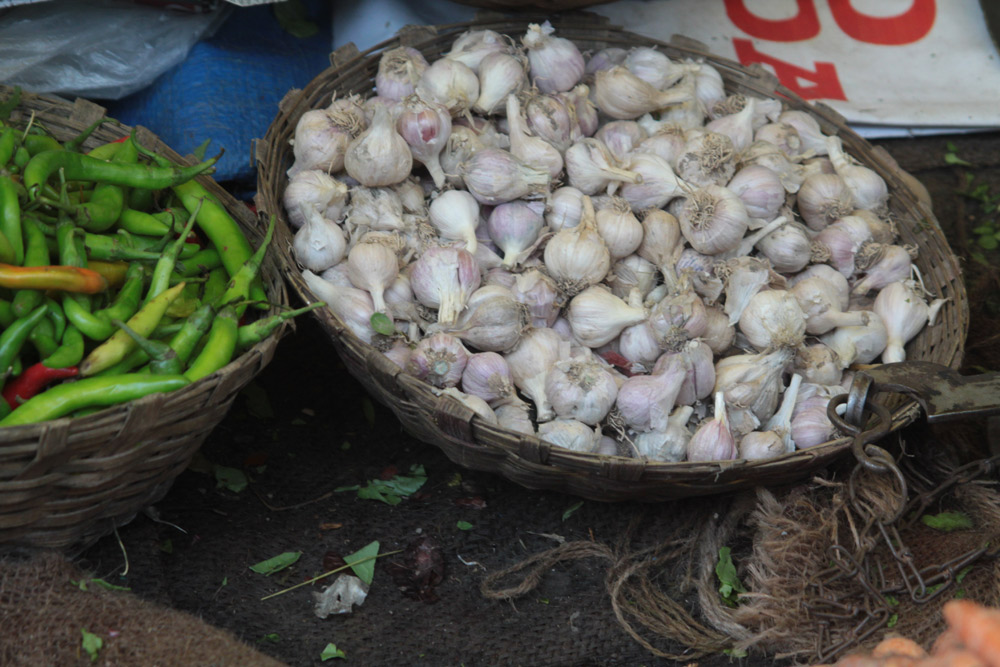
Garlic for cold season? Oh, yes!
October is the perfect time to talk about garlic – and not only because it’s handy to have around should any vampires cross your path on Halloween.
Garlic (Alium sativum) is a wonderfully warming member of the onion family that is highly anti-microbial, just in time for cold and flu season. Braun & Cohen (2015) summarize the scientific literature which suggests that garlic is effective against a wide range of bacteria, including: Esherichia coli, Staphylococcus aureus, Mycobacterium tuberculosis, Proteus spp., Streptococcus faecalis, Pseudomonas aeruginosa, Helicobacter pylori. Garlic was also shown to exhibit anti-fungal activity (Candida albicans), and anti-parasitic activity (Cryptosporidium parvum, Trichomonas vaginalis, Entamoeba histolyca and Giardia lamblia). To round out garlic as a potent ally against infection, in vitro studies show promising results in activating macrophages – cells in our bodies that “eat” invaders as an immune response. In short, garlic does double duty by having both a direct effect on harmful microbes as well as mobilizing your own immune system to join in the fight.
In the Kitchen
There are many (delicious) ways to incorporate garlic into your everyday cooking, especially as the weather cools down. Add peeled, minced garlic to stir-frys or soups, or sprinkle garlic powder on meat for a savory seasoning during cooking. You can even roast garlic whole for a savory, satisfying treat. However you enjoy garlic, be sure to crush or at least bruise it first to get maximum health benefit. This is because garlic contains alliin, an organosulfur compound that, when activated, becomes allicin, which is the constituent largely thought to provide garlic’s health benefits. Crushing the cloves release the enzyme that converts the alliin to allicin.
Worried about the smell?
In large doses, garlic’s volatile oils can be excreted thought the skin, or via the lungs. The latter, Hoffmann (2003) says, is useful in respiratory infections and congestion. On the downside, some people do not like the resultant odor (or mouth taste) that garlic can bring. One option, as I like to tell my clients, is to make sure that everyone at the dinner table eats the garlic such that no one notices the resultant smell. Barring that, there are some garlic supplements available, many of which are enteric-coated which eliminate garlic’s characteristic taste and odor. But for my money, I’ll take whole garlic any day.
Grow your own
In fact, garlic is relatively easy to grow. In temperate climates, October is the perfect time to plant a couple of garlic bulbs in your garden beds, to sleep through the winter and be harvested next summer. Check your local Extension Office for best timing, and simply plant single cloves about 2” deep, 2”-4” apart in rows about a foot apart in well-drained soil in a sunny location. Shoots will emerge in the spring, and the garlic will be ready to harvest mid-summer. More information about growing garlic may be found at my favorite Farmer’s Almanac website, but note that garlic sold in the grocery store is NOT suitable for planting because it is often treated to prolong shelf-life, and it may also carry disease (harmless to humans but not necessarily the soil and surrounding plants).
How much? How often? The last thing I’ll leave you with is ‘how much’ garlic should you consume to be effective? Braun & Cohen (2015) suggest approximately 1 small-to-medium clove/day prophylactically, and Hoffmann (2003) adds that 1 clove three times a day may be indicated during acute infection. Garlic is generally safe in dietary quantities as well these daily doses, though people with bleeding abnormalities should avoid taking high doses. Those with a known allergy to sulfurous vegetables (e.g., onions), and the aforementioned vampires, should avoid garlic altogether.
Sources:
Braun, L. & Cohen, M. (2015). Herbs and Natural Supplements, An Evidence-Based Guide. 4th Ed. Philadelphia: Elsevier.
Hoffmann, D. (2003). Medical Herbalism: The Science and Practice of Herbal Medicine. Rochester, VT: Healing Arts Press.
Donna Koczaja, M.S., RH(AHG) graduated from Maryland University of Integrative Health (formerly Tai Sophia Institute) with a Master of Science in Therapeutic Herbalism and a Post-Master’s Certificate in Clinical Herbalism. She earned Registered Herbalist status from the American Herbalists’ Guild in 2018. Originally educated as a mechanical engineer, she combines the rigor of her original scientific training with the traditional healing art of herbal medicine to partner with her clients to uncover the root cause of their underlying health issues. Also a Master Gardener since 2008, her primary interest is in inspiring others to improve their health and sense of wellbeing through the joys of gardening and the power of natural medicine.
Donna is a professional herbalist, currently practicing at the MUIH Natural Care Center. Read more about her, what she does, and why she does it at www.greenhavenliving.com.
Are you Ready to Ask The Herbalists? Subscribe here!

